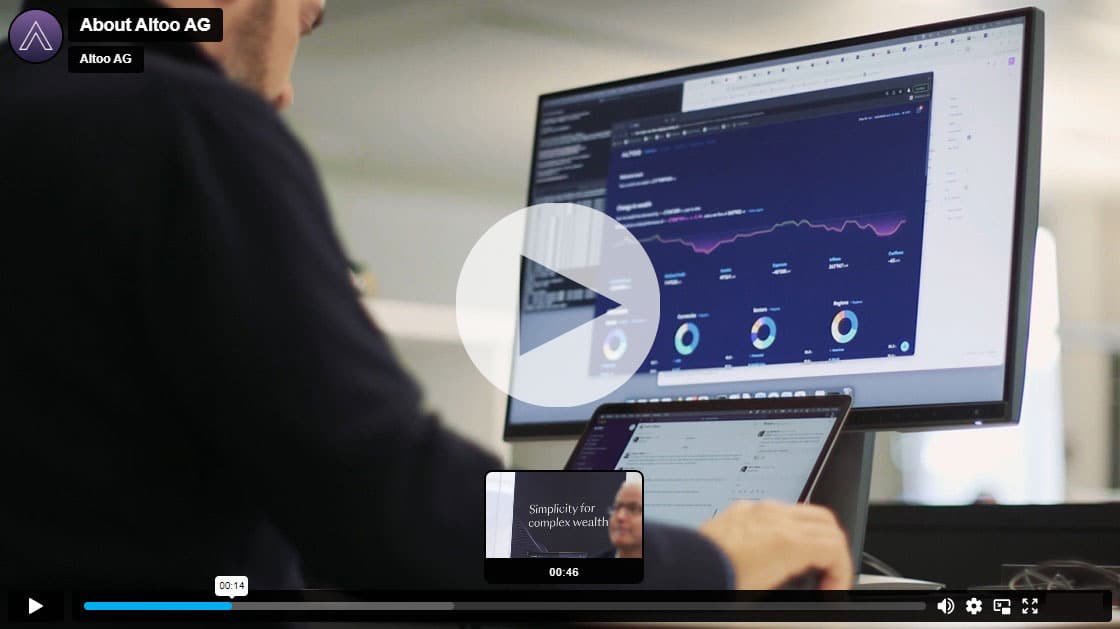This article aims to delve into the transformative potential of Open Banking API in shaping the future of financial management for wealthy individuals. It will discuss what is Open Banking API and how it has the potential to transform the financial ecosystem.
Key Features of Open API Banking
What is Open Banking API ?
Open Application Programming Interfaces APIs are a revolutionary model that allows third-party developers to build applications and services around a financial institution’s existing software.
It acts as a bridge between your bank’s services and other third-party services. What makes this especially appealing for High Net Worth Individuals (HNWIs) and Ultra High Net Worth Individuals (UHNWIs) is the unparalleled access it provides to a range of services and functionalities that can be tailored to fit sophisticated financial portfolios.
Imagine a HNWI with multiple investment accounts, real estate holdings, and various other assets scattered across different banks and financial institutions. Traditionally, he has to log into each institution’s portal separately to manage the assets, track the portfolio’s performance, and even to make simple transactions. This may become an unmanageable range of tasks.
Wealth Aggregation: Simple, Dynamic, and Secure Beyond Compare. Discover the Altoo Wealth Platform!
Now, enter Open Banking API.
With Open Banking API, a third-party financial management app could aggregate all this information for you in real-time. Instead of logging into multiple websites or apps, you could use a single app to view your entire financial landscape. This app could integrate with each of your banks through their Open Banking APIs, pulling data into one dashboard that shows your complete financial status. From this dashboard, you could:
- View the real-time value of your diverse portfolio, including stocks, bonds, and real estate.
- Execute transactions between different accounts, even if they’re at different banks.
- Take advantage of automated tax optimisation strategies tailored to your unique asset mix.
- Set and monitor budgeting goals, as well as expenditure tracking.
In this scenario, Open Banking API simplifies and centralises your financial management process, offering you a consolidated view and streamlined control over your diverse assets. This is particularly advantageous for HNWIs and UHNWIs, who typically have complex financial portfolios spread across multiple platforms.
Below, we delve into the key features that Open Banking API brings to the table.
Asset Management
One of the advantages of Open Banking API lies in its capacity to overhaul traditional asset management. By integrating with a range of services, it allows for real-time tracking of diverse assets, from equities and bonds to real estate and other tangible assets.
- Real-Time Tracking: Get real-time updates on asset performance.
- Diverse Portfolio Management: Easily manage a variety of asset classes through a single interface.
- Automated Reporting: Receive customized reports that provide a holistic view of your asset portfolio.
By enabling real-time tracking and access to transactional data, Open Banking API significantly aids in informed investment decisions, optimizing diverse portfolio management, and improving risk management through automated reporting.
Integrated Financial Strategies
When you are dealing with multiple financial portfolios, one of the biggest challenges is aligning them with your overall financial strategy. Open Banking API excels in this by offering integrated financial solutions that can be customized to suit individual needs. These can include:
- Tax Optimisation: Automated solutions that consider tax implications across diverse assets.
- Investment Pairing: Suggests optimal combinations of investments based on risk tolerance and financial goals.
- Budget and Expense Tracking: Integrates with budgeting tools to provide a complete financial overview.
While these features offer promising avenues for improving financial management, they are not a one-size-fits-all solution. In fact, integrating these strategies might bring complexities and risks, hence the necessity to consult financial advisors for a tailored approach.
The Future of Wealth Management: Open Banking API
The potential for innovation in the financial sectors is robust, owing in part to the flexibility and customization that Open Banking API offers. This is particularly crucial for UHNWIs and HNWIs, who often manage complex portfolios across a range of financial products or services.
Innovation in Wealth Management
The crux of the innovation lies in the democratization of financial data and services. Gone are the days when banks and financial institutions acted as gatekeepers. Open Banking API encourages:
- Streamlined Processes: Simplify complex financial operations, and save time that is usually spent on finance management.
- Data-Driven Decision Making: Offers a seamless way to aggregate and interpret data, making it easier to implement strategic changes.
- Bespoke Financial Products: Allows for the development of custom solutions tailored to individual financial profiles.
Tailored Benefits for UHNWIs and HNWIs
UHNWIs and HNWIs stand to gain significantly from these advancements. The high level of personalization and flexibility provided by Open Banking API is particularly aligned with the needs of those with substantial assets and varied investment portfolios. Here’s why:
- Unified Asset Management: Allows for an integrated overview of different asset classes, simplifying portfolio management.
- Tax Efficiency: Offers automated strategies for optimizing tax liabilities across international borders.
- Enhanced Security: Incorporates advanced security measures to protect high-value transactions and sensitive data.
How Open API Empowers UHNWIs/HNWIs
Open Banking API technology offers solutions that are not just about convenience but also about potentially resolving financial challenges.
Customisation and Personalisation
One of the cornerstones of Open Banking API is the ability to offer tailored financial services and products. UHNWIs and HNWIs often deal with:
- Multi-Currency Accounts: Open Banking API allows seamless handling of different currencies.
- Asset Diversification: Provides an integrated platform that enables effective monitoring of diverse assets like equities, real estate, and bonds.
- Personalised Reporting: Custom reports and real-time analytics to make informed decisions.
Security and Privacy
The value of security multiplies for individuals who manage significant assets. Cybersecurity remains a top concern for wealth managers and their wealthy clients. Open Banking API brings to the table:
- Encryption Protocols: High-level security measures, including advanced encryption protocols, are used to protect data.
- Identity Verification: Two-factor or multi-factor authentication for an added layer of security.
- Regulated Access: Allows controlled access to financial data, ensuring that only authorized personnel can gain entry.
Regulatory Landscape
As Open Banking API gains traction, regulations form the crux that balances innovation with safety. Understanding these norms may be indispensable for UHNWIs and HNWIs to comprehend the safety net that guards their financial interests.
PSD2 and Compliance
At the forefront of these regulatory measures is the Second Payment Services Directive (PSD2), an EU directive that reshapes the financial ecosystem. The revised Payment Services Directive (PSD2) in the European Union (EU) aims to provide more convenient and individualized financial products through open banking (OB) platforms. Here are key aspects UHNWIs and HNWIs should understand:
- Data Sharing: Under PSD2, banks are required to open up their data to regulate third-party providers.
- Consent Mechanism: Before sharing data, explicit consent from the customer is mandatory.
- Enhanced Security: It mandates strong customer authentication, typically involving at least two verification methods.
The adoption of Open Banking API is faster in the European market, primarily due to PSD2 compliance.
Global Regulatory Challenges
While PSD2 sets a precedent, the global scenario is a mosaic of regulatory environments, which includes:
- Non-uniform Regulations: Regulations in the USA or Asia are not entirely in sync with PSD2, leading to potential inconsistencies.
- Data Privacy Laws: Countries have different laws governing data privacy, like GDPR in Europe and CCPA in California, USA, which might conflict with Open API objectives.
- Financial Crimes: The open nature of API Banking raises concerns about potential misuse, making stringent regulations necessary.
The regulatory landscape, including PSD2, is a crucial factor in Open Banking API’s security and potential benefits. However, it’s essential to consider that regulations are subject to change and can vary greatly between regions. For personalised, up-to-date insights, consulting a legal advisor with expertise in international financial regulations is advisable.
Pros and Cons of Open Banking API for UHNWIs
Open Banking API offers a spectrum of possibilities that could revolutionise the financial management landscape for Ultra-High-Net-Worth Individuals (UHNWIs) and High-Net-Worth Individuals (HNWIs). However, it’s essential to weigh both the merits and potential drawbacks.
Pros
Convenience and Accessibility
- 24/7 Services: Open API allows the seamless operation of financial services round-the-clock, freeing UHNWIs from the constraints of banking hours.
- Remote Access: With a robust digital framework, all services can be accessed remotely.
Customisation and Personalisation
- Tailored Solutions: API technology allows for custom financial products that can be specifically designed to meet unique investment needs.
Enhanced Financial Oversight
- Consolidated Data: Open Banking APIs can pull in all financial data into one interface, offering a comprehensive view of one’s assets and liabilities.
Cost-Efficiency
- Automated Services: The use of APIs can automate mundane tasks, thereby reducing the cost of financial management.
Cons
Security Concerns
- Data Breaches: The sharing of sensitive financial data through APIs can increase the vulnerability to cyberattacks.
Regulatory Uncertainty
- Changing Laws: Regulatory frameworks like PSD2 are still relatively new, and legislative changes can impact the risk profile of using open APIs.
Learning Curve
- Complexity: The array of possibilities Open Banking API brings might be overwhelming and may require a deep understanding for effective utilization.
Potential Hidden Costs
- Subscription Fees: Some APIs may involve hidden costs or subscription fees, which could add up over time.
Open Banking API could be a game-changer in the wealth management space. While it offers unprecedented customization and accessibility, it also raises questions about data security and regulatory certainty. It is advisable for UHNWIs and HNWIs to keep a pulse on emerging trends and regulations in this domain and to consult experts to tailor strategies accordingly.









